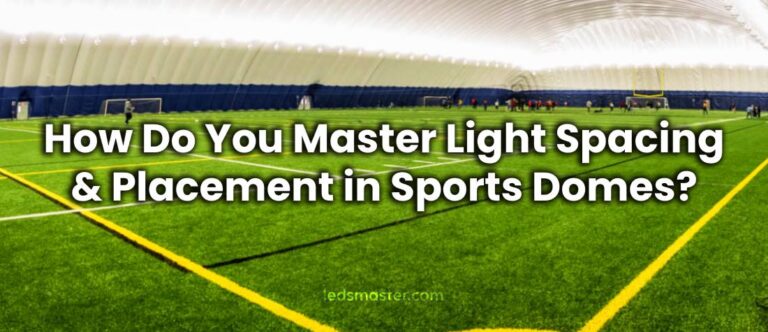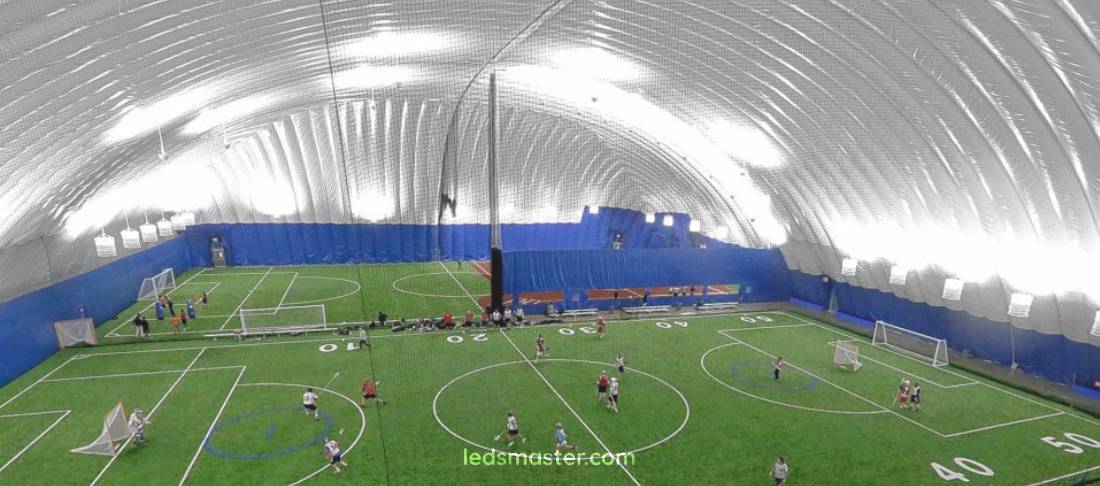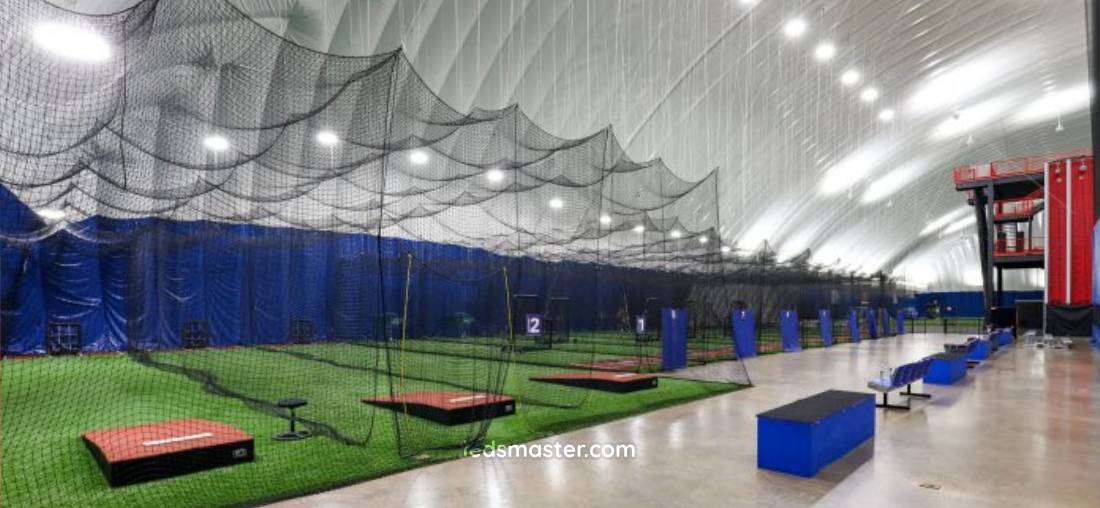
Lighting transforms sports domes into vibrant arenas, ensuring athletes perform at their best and spectators catch every detail. Choosing the right solution, whether the energy-saving brilliance of LEDs or the reliable glow of HID and fluorescent lights, is key to creating the perfect atmosphere. With smart installation and upkeep, the right lighting enhances visibility, performance, and the overall experience for everyone.
Get your complimentary lighting design today
Sports domes, with their expansive interiors and unique structural designs, serve as versatile venues for a range of activities, from community sports leagues to professional tournaments. Proper lighting in these spaces is fundamental to ensuring that both players and spectators experience optimal conditions.
Table of Contents
Toggle
LED lighting has become a popular choice for sports dome installations due to its numerous advantages. LEDs are highly energy-efficient, consuming less power compared to traditional lighting solutions while providing the same, if not better, levels of brightness. Their long lifespan means that they require less frequent replacement, reducing maintenance costs and minimizing disruptions.
In sports domes, LED lights can deliver bright, uniform illumination that enhances visibility across the entire field or court. This uniformity is vital for maintaining consistent playing conditions and ensuring that players can perform at their best. Additionally, LEDs offer flexibility in color temperature, which can be adjusted to suit different types of sports and events.
High-Intensity Discharge (HID) lighting, including metal halide and high-pressure sodium lamps, has been a long-standing option for large indoor spaces like sports domes. Metal halide lamps are known for their excellent color rendering and high lumen output, making them suitable for environments where visual clarity is crucial. However, they have a longer warm-up time and a shorter lifespan compared to LEDs.
High-pressure sodium lamps are another type of HID lighting, favored for their efficiency and long life. They provide a warm light that is less desirable for applications requiring true color representation but is effective for general illumination. While HID lights are being gradually replaced by LEDs in many installations due to their superior efficiency and performance, they can still be found in older sports dome facilities.
Fluorescent lighting offers a balance between cost and performance. It provides a diffuse, even light that can effectively illuminate large areas. Though not as efficient as LEDs, fluorescent lights are generally more energy-efficient than traditional incandescent bulbs. They also have a relatively good color rendering index, making them a viable option for sports domes where high light quality is necessary.
Fluorescent lights are often used in combination with other lighting types to achieve the desired illumination levels. They are typically found in older installations or as supplementary lighting in newer systems.

Proper placement and mounting of lighting fixtures are key to achieving optimal performance. In a sports dome, fixtures are typically mounted on the ceiling or rafters. The height of mounting should be sufficient to cover the playing area effectively without causing glare or shadows. Strategic placement helps ensure that light is distributed evenly and that all areas are adequately illuminated.
The mounting system must be robust and secure to withstand the rigors of a sports environment. Fixtures should be installed with proper alignment to avoid any misdirection of light and ensure uniform coverage.
The wiring and power supply for sports dome lighting must be designed to handle the load of the installed fixtures. Adequate electrical capacity and safety measures are crucial to prevent overheating and ensure reliable operation. Electrical installations should comply with local codes and standards to ensure safety and efficiency.
For large sports domes, it may be necessary to use a combination of circuits to distribute the electrical load evenly. This approach helps in managing power consumption and facilitates easier maintenance.
Sports domes often have existing systems such as HVAC and sound systems. Integrating new lighting with these systems requires careful planning to avoid interference and ensure seamless operation. Coordination with other systems can help in managing the overall energy consumption and maintaining the efficiency of the dome’s infrastructure.
Lighting controls should be compatible with existing systems, allowing for easy adjustments and automation. This integration can enhance the overall functionality of the dome and provide a better experience for users.
Routine inspections are necessary to ensure that the lighting system operates efficiently and safely. Regular checks help identify any issues such as flickering lights, dim spots, or damaged fixtures. Inspections should be conducted at planned intervals to prevent minor issues from escalating into major problems.
During inspections, attention should be paid to the cleanliness of fixtures and the condition of wiring and electrical components. Keeping the system in good condition helps maintain optimal performance and prolongs the lifespan of the lighting equipment.
Cleaning and servicing are important for maintaining the effectiveness of the lighting system. Dust and debris can accumulate on fixtures, reducing their light output and efficiency. Regular cleaning helps ensure that fixtures deliver consistent illumination and operate at peak performance.
Servicing includes checking and replacing any worn-out or damaged components. For LED lights, this may involve replacing individual modules or drivers, while HID and fluorescent lights may require bulb replacements.
Over time, bulbs and fixtures may need to be replaced due to wear and tear. The replacement process should be carried out with care to ensure that the new components match the specifications of the existing system. For high-mounted fixtures, professional assistance may be required to safely perform replacements.
Proper disposal of old bulbs and fixtures is also important, particularly for types that contain hazardous materials. Adhering to disposal regulations helps in managing environmental impact and maintaining safety standards.
Energy consumption is a significant consideration in sports dome lighting. LED lighting stands out for its low power usage compared to traditional lighting options like HID and fluorescent. Reducing energy consumption not only lowers operational costs but also contributes to environmental sustainability.
When planning for energy efficiency, it is essential to consider the total energy footprint of the lighting system, including the potential for integrating energy-saving technologies such as automated controls and dimming systems.
Incorporating sustainable practices into the lighting installation can further enhance the environmental benefits. Using energy-efficient fixtures and adopting practices that reduce energy waste are key aspects of sustainability. Additionally, selecting lighting products made from recyclable materials and promoting proper disposal methods align with broader environmental goals.
Sports dome lighting involves careful consideration of various factors to ensure that the space is adequately illuminated for both players and spectators. From choosing the right type of lighting to following best practices in installation and maintenance, each aspect plays a role in creating an optimal environment. By focusing on these elements, sports dome facilities can enhance performance, safety, and overall enjoyment.